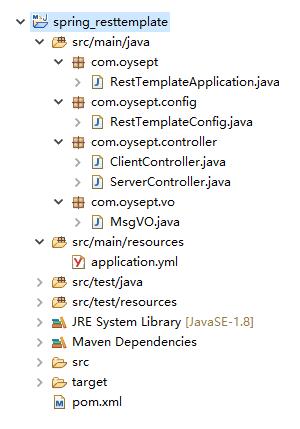您好,登錄后才能下訂單哦!
您好,登錄后才能下訂單哦!
一)RestTemplate簡介
RestTemplate是HTTP客戶端庫提供了一個更高水平的API。主要用于Rest服務調用。
RestTemplate方法:
| 方法組 | 描述 |
|---|---|
|
getForObject |
通過GET檢索表示形式。 |
|
getForEntity |
ResponseEntity通過使用GET 檢索(即狀態,標頭和正文)。 |
|
headForHeaders |
通過使用HEAD檢索資源的所有標頭。 |
|
postForLocation |
通過使用POST創建新資源,并Location從響應中返回標頭。 |
|
postForObject |
通過使用POST創建新資源,并從響應中返回表示形式。 |
|
postForEntity |
通過使用POST創建新資源,并從響應中返回表示形式。 |
|
put |
通過使用PUT創建或更新資源。 |
|
patchForObject |
通過使用PATCH更新資源,并從響應中返回表示形式。請注意,JDK HttpURLConnection不支持PATCH,但是Apache HttpComponents和其他支持。 |
|
delete |
使用DELETE刪除指定URI處的資源。 |
|
optionsForAllow |
通過使用ALLOW檢索資源的允許的HTTP方法。 |
|
exchange |
前述方法的通用性強(且意見少的版本),在需要時提供了額外的靈活性。它接受RequestEntity(包括HTTP方法,URL,標頭和正文作為輸入)并返回ResponseEntity。 這些方法允許使用ParameterizedTypeReference而不是Class使用泛型來指定響應類型。 |
|
execute |
執行請求的最通用方法,完全控制通過回調接口進行的請求準備和響應提取。 |
二)RestTemplate案例
第一步:創建一個maven項目,在pom.xml引入一個springboot的版本
pom.xml內容:
<project xmlns="http://maven.apache.org/POM/4.0.0" xmlns:xsi="http://www.w3.org/2001/XMLSchema-instance" xsi:schemaLocation="http://maven.apache.org/POM/4.0.0 http://maven.apache.org/xsd/maven-4.0.0.xsd">
<modelVersion>4.0.0</modelVersion>
<groupId>com.oysept</groupId>
<artifactId>spring_resttemplate</artifactId>
<version>0.0.1-SNAPSHOT</version>
<packaging>jar</packaging>
<parent>
<groupId>org.springframework.boot</groupId>
<artifactId>spring-boot-starter-parent</artifactId>
<version>2.1.4.RELEASE</version>
<relativePath/>
</parent>
<dependencies>
<dependency>
<groupId>org.springframework.boot</groupId>
<artifactId>spring-boot-starter-web</artifactId>
</dependency>
</dependencies>
<build>
<plugins>
<plugin>
<groupId>org.springframework.boot</groupId>
<artifactId>spring-boot-maven-plugin</artifactId>
<configuration>
<mainClass>com.oysept.RestTemplateApplication</mainClass>
</configuration>
</plugin>
<plugin>
<groupId>org.apache.tomcat.maven</groupId>
<artifactId>tomcat7-maven-plugin</artifactId>
</plugin>
</plugins>
</build>
</project>
application.yml配置:該配置就一個默認端口
server:
port: 8080
創建一個springboot啟動類RestTemplateApplication
package com.oysept;
import org.springframework.boot.autoconfigure.SpringBootApplication;
import org.springframework.boot.builder.SpringApplicationBuilder;
@SpringBootApplication
public class RestTemplateApplication {
public static void main(String[] args) {
new SpringApplicationBuilder(RestTemplateApplication.class).run(args);
}
}
到此步驟時,可以先運行RestTemplateApplication中的main方法,檢驗springboot啟動是否正常。
第二步:創建一個RestTemplate配置類并注入,因為在使用時,不提前注入ResttTemplate,在通過@Autowired使用會報RestTemplate找不到
package com.oysept.config;
import org.springframework.context.annotation.Bean;
import org.springframework.context.annotation.Configuration;
import org.springframework.web.client.RestTemplate;
/**
* 注冊一個RestTemplate Bean, 否則直接通過@Autowired使用會報RestTemplate找不到
* @author ouyangjun
*/
@Configuration
public class RestTemplateConfig {
/**
* 方式一: 默認是使用JDK原生java.net.HttpURLConnection請求
* @return
*/
@Bean(name = "restTemplate")
public RestTemplate restTemplate() {
return new RestTemplate();
}
/**
* 方式二: 使用apache http內置請求, 需要在pom.xml中引入相應的apache jar
* 可以使用HttpClient,設置一些http連接池等信息
* @return
*
@Bean(name = "restTemplate")
public RestTemplate restTemplate() {
return new RestTemplate(new HttpComponentsClientHttpRequestFactory());
}
*/
/**
* 方式三: 使用OkHttp內置請求, 需要在pom.xml中引入相應的OkHttp3 jar
* 可以使用OkHttpClient,設置一些http連接池信息
* @return
*
@Bean(name = "restTemplate")
public RestTemplate restTemplate() {
return new RestTemplate(new OkHttp3ClientHttpRequestFactory());
}
*/
}
第三步:創建一個VO類,用于測試入參和出參
package com.oysept.vo;
public class MsgVO {
private String msgKey;
private String msgValue;
public String getMsgKey() {return msgKey;}
public void setMsgKey(String msgKey) {this.msgKey = msgKey;}
public String getMsgValue() {return msgValue;}
public void setMsgValue(String msgValue) {this.msgValue = msgValue;}
public String toString() {
return "MsgVO [msgKey: "+this.msgKey+", msgValue: "+this.msgValue+"]";
}
}
第四步:創建一個服務端接口,用于測試
package com.oysept.controller;
import java.util.ArrayList;
import java.util.List;
import org.springframework.http.MediaType;
import org.springframework.web.bind.annotation.PathVariable;
import org.springframework.web.bind.annotation.RequestBody;
import org.springframework.web.bind.annotation.RequestMapping;
import org.springframework.web.bind.annotation.RequestMethod;
import org.springframework.web.bind.annotation.RequestParam;
import org.springframework.web.bind.annotation.RestController;
import com.oysept.vo.MsgVO;
/**
* 服務端, 提供接口被調用
* @author ouyangjun
*/
@RestController
public class ServerController {
// 無參GET請求: http://localhost:8080/server/get
@RequestMapping(value = "/server/get", method = RequestMethod.GET)
public String get() {
return "/server/get";
}
// 帶參GET請求: http://localhost:8080/server/get/param?param=111222333444
@RequestMapping(value = "/server/get/param", method = RequestMethod.GET)
public String getParam(@RequestParam(value = "param") String param) {
return "/server/get/param," + param;
}
// 路徑中帶參GET請求: http://localhost:8080/server/get/url/AAAA/BBBB
@RequestMapping(value = "/server/get/url/{one}/{two}", method = RequestMethod.GET)
public String getUrl(@PathVariable("one") String one, @PathVariable("two") String two) {
return "/get/url/{one}/{two}," + one + "," + two;
}
// 無參GET請求, 返回List: http://localhost:8080/server/get/list
@RequestMapping(value = "/server/get/list", method = RequestMethod.GET)
public List<Object> getList() {
List<Object> list = new ArrayList<Object>();
list.add(11);
list.add("AA");
return list;
}
// 無參GET請求, 返回對象: http://localhost:8080/server/get/MsgVO
@RequestMapping(value = "/server/get/MsgVO", method = RequestMethod.GET)
public MsgVO getMsgVO() {
MsgVO vo = new MsgVO();
vo.setMsgKey("keyAAA");
vo.setMsgValue("valueBBB");
return vo;
}
// POST請求, 表單參數, application/x-www-form-urlencoded
@RequestMapping(value = "/server/post/form", method = RequestMethod.POST,
consumes = MediaType.APPLICATION_FORM_URLENCODED_VALUE)
public MsgVO postForm(MsgVO msgVO) {
System.out.println("msgKey: " + msgVO.getMsgKey() + ", msgValue: " + msgVO.getMsgValue());
return msgVO;
}
// POST請求, JSON參數, application/json
@RequestMapping(value = "/server/post/json", method = RequestMethod.POST,
consumes = MediaType.APPLICATION_JSON_UTF8_VALUE,
produces = MediaType.APPLICATION_JSON_UTF8_VALUE)
public MsgVO postJson(@RequestBody MsgVO msgVO) {
System.out.println("msgKey: " + msgVO.getMsgKey() + ", msgValue: " + msgVO.getMsgValue());
return msgVO;
}
}
第五步:創建一個測試服務端接口的API
import的類和注入的RestTemplate:
package com.oysept.controller;
import java.net.URI;
import java.util.HashMap;
import java.util.List;
import java.util.Map;
import org.springframework.beans.factory.annotation.Autowired;
import org.springframework.beans.factory.annotation.Qualifier;
import org.springframework.http.HttpEntity;
import org.springframework.http.HttpHeaders;
import org.springframework.http.MediaType;
import org.springframework.http.RequestEntity;
import org.springframework.http.ResponseEntity;
import org.springframework.util.LinkedMultiValueMap;
import org.springframework.util.MultiValueMap;
import org.springframework.web.bind.annotation.RequestMapping;
import org.springframework.web.bind.annotation.RequestMethod;
import org.springframework.web.bind.annotation.RestController;
import org.springframework.web.client.RestTemplate;
import org.springframework.web.util.UriComponentsBuilder;
import com.oysept.vo.MsgVO;
/**
* 客戶端, 調用服務端提供的接口
* @author ouyangjun
*/
@RestController
public class ClientController {
// 使用默認請求方式
@Autowired
@Qualifier(value = "restTemplate")
private RestTemplate restTemplate;
// 在此處添加客戶端測試代碼
}
1、GET請求
// 直接在瀏覽中輸入訪問地址: http://localhost:8080/client/get
@RequestMapping(value = "/client/get", method = RequestMethod.GET)
public String get() {
// 無參GET請求
String get = restTemplate.getForObject("http://localhost:8080/server/get", String.class);
System.out.println("==>/server/get return: " + get);
// 帶參GET請求
String getParam = restTemplate.getForObject("http://localhost:8080/server/get/param?param=111222333444", String.class);
System.out.println("==>/server/get/param return: " + getParam);
// 帶參GET url請求
String getUrlParam = restTemplate.getForObject("http://localhost:8080/server/get/url/{one}/{two}", String.class, "AAAA", "BBBB");
System.out.println("==>/server/get/url/{one}/{two} return: " + getUrlParam);
// 帶參GET url請求
Map<String, String> vars = new HashMap<String, String>();
vars.put("one", "HHHH");
vars.put("two", "EEEE");
String getUrlVars = restTemplate.getForObject("http://localhost:8080/server/get/url/{one}/{two}", String.class, vars);
System.out.println("==>/server/get/url/{one}/{two} return: " + getUrlVars);
// 無參GET請求, 返回List
@SuppressWarnings("unchecked")
List<String> getList = restTemplate.getForObject("http://localhost:8080/server/get/list", List.class);
System.out.println("==>/server/get/list return: " + getList);
// GET請求, 返回對象
ResponseEntity<MsgVO> entity = restTemplate.getForEntity("http://localhost:8080/server/get/MsgVO", MsgVO.class);
System.out.println("==>/server/get/list return: " + entity.getBody());
return "GET SUCCESS";
}
2、GET url中傳參請求
// 直接在瀏覽中輸入訪問地址: http://localhost:8080/client/get/request
// GET請求, url參數, 在表頭中添加參數
@RequestMapping(value = "/client/get/request", method = RequestMethod.GET)
public String getRequest() {
// url中參數
Map<String, String> vars = new HashMap<String, String>();
vars.put("one", "HHHH");
vars.put("two", "EEEE");
// 請求地址
String uriTemplate = "http://localhost:8080/server/get/url/{one}/{two}";
// 給URL地址encode轉碼
URI uri = UriComponentsBuilder.fromUriString(uriTemplate).buildAndExpand(vars).toUri();
// GET請求參數
RequestEntity<Void> requestEntity =
RequestEntity.get(uri)
.header("MyHeader", "aaabbbcccddd")
.build();
// 響應
ResponseEntity<String> response = restTemplate.exchange(requestEntity, String.class);
// 結果
System.out.println("==>/get/request header: " + response.getHeaders().getFirst("MyHeader"));
System.out.println("==>/get/request body: " + response.getBody());
return "POST SUCCESS";
}
3、POST application/x-www-form-urlencoded表單傳參請求
// 直接在瀏覽中輸入訪問地址: http://localhost:8080/client/postForm
// POST請求, form表單入參
@RequestMapping(value = "/client/postForm", method = RequestMethod.GET)
public String postForm() {
// uri
String uriTemplate = "http://localhost:8080/server/post/form";
// 設置請求頭為form形式: application/x-www-form-urlencoded
HttpHeaders headers = new HttpHeaders();
headers.setContentType(MediaType.APPLICATION_FORM_URLENCODED);
// 設置參數, 和MsgVO中變量名對應
MultiValueMap<String, String> map = new LinkedMultiValueMap<String, String>();
map.add("msgKey", "1234");
map.add("msgValue", "TestTest");
// 封裝請求參數
HttpEntity<MultiValueMap<String, String>> requestb = new HttpEntity<MultiValueMap<String, String>>(map,
headers);
ResponseEntity<String> response = restTemplate.postForEntity(uriTemplate, requestb, String.class);
System.out.println("==>/server/post/form return: " + response.getBody());
return "POST SUCCESS";
}
4、POST application/json JSON傳參請求
// 直接在瀏覽中輸入訪問地址: http://localhost:8080/client/postJson
// POST請求, JSON入參
@RequestMapping(value = "/client/postJson", method = RequestMethod.GET)
public String postJson() {
// json入參
MsgVO vo = new MsgVO();
vo.setMsgKey("TTT");
vo.setMsgValue("KKK");
String uriTemplate = "http://localhost:8080/server/post/json";
URI uri = UriComponentsBuilder.fromUriString(uriTemplate).buildAndExpand().toUri();
RequestEntity<MsgVO> requestEntity =
RequestEntity.post(uri)
.header("Content-Type", "application/json; charset=UTF-8")
.body(vo);
ResponseEntity<MsgVO> response = restTemplate.exchange(requestEntity, MsgVO.class);
System.out.println("==>/server/post/json return: " + response.getBody());
return "POST SUCCESS";
}
項目結構圖:

以上這篇SpringBoot RestTemplate GET POST請求的實例講解就是小編分享給大家的全部內容了,希望能給大家一個參考,也希望大家多多支持億速云。
免責聲明:本站發布的內容(圖片、視頻和文字)以原創、轉載和分享為主,文章觀點不代表本網站立場,如果涉及侵權請聯系站長郵箱:is@yisu.com進行舉報,并提供相關證據,一經查實,將立刻刪除涉嫌侵權內容。